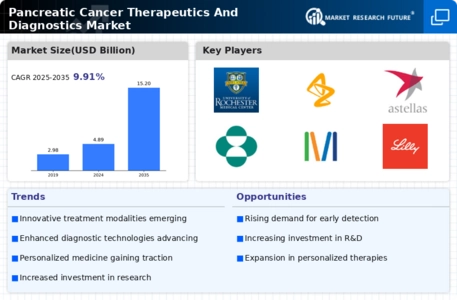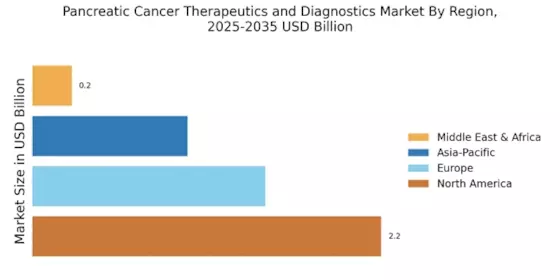Growing Awareness and Education
Growing awareness and education regarding pancreatic cancer are pivotal in shaping the Pancreatic Cancer Therapeutics And Diagnostics Market. Increased public and professional awareness campaigns are leading to better understanding of the disease, its symptoms, and the importance of early detection. Organizations dedicated to pancreatic cancer advocacy are actively promoting educational initiatives that inform both patients and healthcare providers about the latest advancements in treatment and diagnostics. This heightened awareness is likely to result in more individuals seeking medical attention at earlier stages of the disease, thereby increasing the demand for diagnostic services and therapeutic options. As awareness continues to grow, the market is expected to expand, driven by a more informed patient population.
Rising Incidence of Pancreatic Cancer
The increasing incidence of pancreatic cancer is a primary driver for the Pancreatic Cancer Therapeutics And Diagnostics Market. According to recent statistics, pancreatic cancer is projected to become the second leading cause of cancer-related deaths by 2030. This alarming trend necessitates the development of effective therapeutic options and advanced diagnostic tools. As the population ages and lifestyle factors contribute to higher cancer rates, the demand for innovative treatments and early detection methods intensifies. The market is responding to this need with a surge in research and development activities aimed at discovering novel therapies and improving diagnostic accuracy. Consequently, the rising incidence of pancreatic cancer is likely to propel growth in the market, as healthcare providers and patients seek more effective solutions.
Increased Investment in Cancer Research
Increased investment in cancer research is a crucial driver for the Pancreatic Cancer Therapeutics And Diagnostics Market. Governments and private organizations are allocating substantial funds to support research initiatives aimed at understanding pancreatic cancer biology and developing new therapeutic agents. For example, funding for clinical trials and research programs has seen a notable rise, with billions of dollars being invested annually. This influx of capital is fostering innovation in drug development and diagnostic technologies, leading to the emergence of novel therapies and improved diagnostic tools. As research progresses, the market is likely to witness the introduction of breakthrough treatments that could significantly alter the treatment landscape for pancreatic cancer, thereby driving market growth.
Technological Advancements in Diagnostics
Technological advancements in diagnostic methodologies are significantly influencing the Pancreatic Cancer Therapeutics And Diagnostics Market. Innovations such as liquid biopsies, advanced imaging techniques, and molecular profiling are enhancing the ability to detect pancreatic cancer at earlier stages. For instance, the integration of next-generation sequencing has improved the identification of genetic mutations associated with pancreatic cancer, allowing for more personalized treatment approaches. The market for diagnostic tools is expected to grow substantially, with estimates suggesting a compound annual growth rate of over 10% in the coming years. These advancements not only facilitate timely diagnosis but also enable healthcare professionals to tailor treatment plans based on individual patient profiles, thereby improving overall outcomes.
Regulatory Support for Innovative Therapies
Regulatory support for innovative therapies is emerging as a significant driver for the Pancreatic Cancer Therapeutics And Diagnostics Market. Regulatory agencies are increasingly recognizing the urgent need for new treatment options for pancreatic cancer, leading to expedited approval processes for promising therapies. Initiatives such as breakthrough therapy designations and fast-track approvals are facilitating quicker access to novel treatments for patients. This supportive regulatory environment encourages pharmaceutical companies to invest in research and development, knowing that their innovative solutions may reach the market more rapidly. As a result, the market is likely to experience a surge in the availability of new therapeutic options, which could enhance treatment outcomes and ultimately drive market growth.


















Leave a Comment